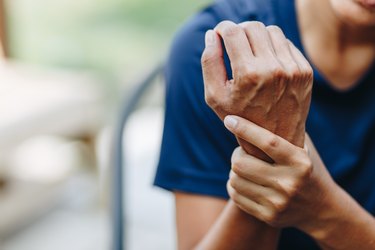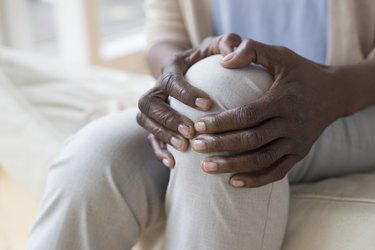
If you're plagued by persistent aches, stiffness or swelling in one or both knees, you could have arthritis. This common condition is often the result of age-related wear and tear or injuries, but arthritis in the knees (or elsewhere) can affect younger adults in some cases.
Here's how to tell if your knee symptoms could be arthritis, plus what you can do to get your discomfort under control.
Video of the Day
Video of the Day
What Causes Knee Arthritis?
Arthritis is a general condition that causes pain, swelling and stiffness in the joints, including in the knees. There are more than 100 types of arthritis, but the two most likely to affect your knees are osteoarthritis and rheumatoid arthritis, says Amro Balki, MD, a board-certified rheumatologist at Providence Saint John's Health Center in Santa Monica, California.
- Osteoarthritis is a type of arthritis caused by simple wear and tear. Over time, repeated movements can wear away the cartilage around the knee joint, causing the knee bones to rub against each other. You're more likely to get osteoarthritis in your knees if you're older, you put repeated stress on your knees or if you have a knee injury, notes the Cleveland Clinic.
- Rheumatoid arthritis is an autoimmune disease where the immune system mistakenly attacks healthy joint tissue, including joint tissue in the knees. Anyone can get rheumatoid arthritis, but it's most often diagnosed in women ages 30 to 60, the Cleveland Clinic says.
What Does Knee Arthritis Feel Like?
Both osteoarthritis and rheumatoid arthritis can cause knee pain, swelling and stiffness that make it harder to comfortably move your knee and perform everyday activities like walking, running or climbing the stairs.
But there's an important difference. "Osteoarthritis presents with pain with activities and relief with rest, whereas rheumatoid arthritis presents with morning stiffness or pain, and pain with rest and relief with activities," Dr. Balki says.
Rheumatoid arthritis can also cause symptoms elsewhere in the body. The pain, aching or swelling typically affects several joints (on both sides of the body) and can cause fatigue, weakness, fever or weight loss, per the Centers for Disease Control and Prevention.
Knee osteoarthritis pain, on the other hand, usually only occurs in the knees, and just one knee can be affected.
How Knee Arthritis Is Diagnosed
Diagnosing knee arthritis starts with a knee X-ray or other imaging tests like an MRI or CT scan. They can help your doctor see your knee bones, cartilage and any surrounding inflammation, the Cleveland Clinic notes.
Your doctor might also order blood tests to check your white blood cell count, red blood cell count and other measures that can help determine whether your knee arthritis is rheumatoid arthritis.
Treating and Managing Knee Arthritis

Medication often plays a key role in arthritis treatment, especially for rheumatoid arthritis. But there are other strategies that can also be helpful.
1. Medications
Over-the-counter pain relievers like aspirin and ibuprofen or topical pain-relief creams can reduce inflammation and ease osteoarthritis discomfort in the short-term, while corticosteroids (prescription anti-inflammatory meds) can be more effective at managing long-term inflammation and swelling, notes Johns Hopkins Medicine.
Rheumatoid arthritis, on the other hand, usually requires more powerful prescription medications. "Delaying treatment will likely lead to irreversible joint damage," Dr. Balki says.
Depending on your symptoms, your doctor might recommend a disease-modifying antirheumatic drug (DMARD) like methotrexate, a biologic or a janus kinase (JAK) inhibitor, according to the Arthritis Foundation.
2. Non-Medical Pain Management
Other strategies can work in tandem with your medications to make your knee pain more manageable. According to Johns Hopkins Medicine, natural remedies for arthritis pain relief include:
- Using a heating pad or ice pack
- Wearing a splint or brace to rest your knee joint
- Gentle massage
- Transcutaneous electrical nerve stimulation (TENS), which uses mild electrical signals to block nerve impulses
- Acupuncture
3. Exercise
Regular physical activity can reduce joint stiffness and strengthen the surrounding muscles, which can help you manage your knee pain, Dr. Balki says.
The key is sticking with low-impact activities that don't put too much pressure on your joints. Think: stretching, strength-training, walking, bicycling, swimming or water aerobics, the Mayo Clinic says.
While it's good to aim for some form of movement every day, be mindful about not pushing yourself too hard. If exercise leaves you stiff, uncomfortable or exhausted, ease up on your activity. On days when your knees are really bothering you or you could just use a break, it's OK to rest.
4. Lifestyle Changes
Healthy habits can be powerful. Here are some more ways you can keep your arthritis pain in check and keep the problem from getting worse.
- Maintain a healthy weight. Excess weight puts more pressure on your knees, which can exacerbate stiffness and discomfort. Having overweight may also decrease the effectiveness of rheumatoid arthritis medication, Dr. Balki says.
- Prioritize sleep. Sleep deprivation can make arthritis pain worse, so make smart bedtime habits a priority. If you're struggling to sleep because you're in pain, placing a pillow under your knees (for back sleepers) or between your knees (for side sleepers) can ease some of the pressure, the Arthritis Foundation says.
- Eat a healthy diet. Choosing wholesome foods can help you keep your weight in check. Plus, antioxidant-rich foods like fruits and vegetables might play a role in reducing inflammation, notes Harvard Health Publishing.
5. Surgery
Depending on your arthritis type and symptoms, surgical options like arthroscopy, fusion or joint replacement may be helpful when medication and lifestyle changes haven't done enough, Johns Hopkins Medicine notes.
Your doctor can help you weigh the risks and benefits to decide if surgery is right for you.
Preventing Knee Arthritis
While there's no surefire way to prevent arthritis, there are steps you can take to reduce your risk:
- Maintain a healthy weight: Carrying more weight puts more pressure on your knees and ups your risk for osteoarthritis, Dr. Balki says.
- Play safe: If you play sports, make sure to engage in safe play with the proper equipment to reduce your risk for injuries, recommends the Arthritis Foundation.
- Stop smoking: Quitting smoking will reduce your risk for rheumatoid arthritis, because the toxic chemicals in cigarette smoke can stress joint tissues, the Mayo Clinic points out.
- Eat a healthy diet: Prioritizing foods rich in omega-3 fatty acids (i.e. fatty fish like salmon, flax and chia seeds, tofu, walnuts) and limiting your intake of alcohol and sugary beverages may also be protective, suggests one July 2019 Clinical Therapeutics review.
When to See a Doctor
It's a good idea to let your doctor know if you're experiencing knee pain, swelling or stiffness that isn't getting better with rest or other at-home measures.
Based on your symptoms, your doctor can refer you to a specialist like an orthopedist or a rheumatologist to diagnose your arthritis and start treatment.
- Cleveland Clinic: "Arthritis of the Knee"
- Cleveland Clinic: Rheumatoid Arthritis
- Centers for Disease Control and Prevention: "Rheumatoid Arthritis"
- Johns Hopkins Medicine: "Arthritis"
- Arthritis Foundation: "Treatments For Rheumatoid Arthritis"
- Mayo Clinic: "Arthritis"
- Arthritis Foundation: "Position Yourself for a Good Night’s Sleep"
- Harvard Health Publishing: "An anti-inflammatory diet may be good for your joints"
- Arthritis Foundation: "How to Reduce Your Risk of Arthritis"
- Clinical Therapeutics: "Potential of Lifestyle Changes for Reducing the Risk of Developing Rheumatoid Arthritis: Is an Ounce of Prevention Worth a Pound of Cure?"
Is this an emergency? If you are experiencing serious medical symptoms, please see the National Library of Medicine’s list of signs you need emergency medical attention or call 911.






